 Cosmetic dentistry experienced a renaissance in the 1980s as more and more Americans purchased do-it-yourself products to bleach their teeth. Americans now spend approximately 15 billion dollars annually on over-the-counter products and professional tooth whitening services.
Cosmetic dentistry experienced a renaissance in the 1980s as more and more Americans purchased do-it-yourself products to bleach their teeth. Americans now spend approximately 15 billion dollars annually on over-the-counter products and professional tooth whitening services.
The Rising Popularity of Teeth Whitening
The Food and Drug Administration claims that whitening restores the tooth’s natural sheen whereas bleaching whitens beyond the natural tooth’s color. That said, most people consider tooth whitening and tooth bleaching to be virtually synonymous terms.
Teeth whitening is now the most sought after procedure in cosmetic dentistry. Americans spend tens of billions of dollars every year in efforts to improve their smiles. In fact, over 100 million Americans, or approximately one out of every three people you see, are reported to make an effort to whiten their teeth.
Benefits and Risks of Teeth Whitening
Before getting into the upsides and downsides of teeth whitening, it’s important to look at what actually causes tooth discoloration. Major risk factors for tooth discoloration are mostly things totally within your control. The consumption of tea, coffee, sodas and wine are all associated with tooth discoloration.
Benefits of Teeth Whitening
Now, the chief benefit of teeth whitening is obviously a more sterling smile. People who routinely get their teeth whitened report smiling more and feeling less self-conscious about their smiles.
As an added bonus to having a better smile, it’s been said that having a whiter set of teeth actually reduces the appearance of facial wrinkles. This could lend years to your appearance and lead to increased self-confidence.
Drawbacks of Teeth Whitening
If teeth whitening is accomplished through bleaching, there could be some short-term issues. Your teeth or gums might be swollen following a tooth bleaching procedure.
When people get gel bleaching done, sometimes the combination of oxidizing agents and unprotected gum tissue leads to chemical abrasions and sore teeth.
The most commonly reported side effects of tooth bleaching are tooth sensitivity and some irritation of the soft tissue (e.g., gums) in the mouth. Some people report that tooth sensitivity issues are only a problem in the initial stages of the tooth bleaching process.
Sometimes the color contrast between your enamel and any filings you have in your mouth can increase after a tooth whitening procedure.
General Precautions Against Bleaching
- Pregnant women or women who are lactating are recommended not to have bleaching done. Also, minors are cautioned against getting their teeth bleached.
- Before age 16, the nerve of the tooth, known as the pulp chamber, is oversized. Getting your teeth bleached under age 16, therefore, can lead to pulp irritation or sensitivity in that region of the mouth.
- Generally speaking, though, bleaching is reported to be totally effective in approximately 80% of people who undergo the procedure.
- In cases of severe discoloration, getting crowns or veneers is sometimes recommended by dentists instead of getting routine bleaching done.
Costs Associated with Teeth Whitening
- In-home teeth bleaching tends to be the cheapest teeth whitening procedure. Teeth whitening kits can be purchased for around fifty to one hundred dollars.
- On the high end, laser teeth whitening usually costs around one thousand dollars, although the results can last months. A laser teeth whitening treatment can take as little as thirty minutes.
- Normally an LED light activates gel components in the mouth and creates a smile that is up to a dozen shades whiter than the one you walked into the office with.
- The side effects from teeth whitening tend to be generally minor. Tooth sensitivity and swollen or bleeding gums are the most frequently reported problems associated with teeth whitening and bleaching.
If you’re interested in teeth whitening, contact Smile Matters in Fremont, CA for a free consultation.